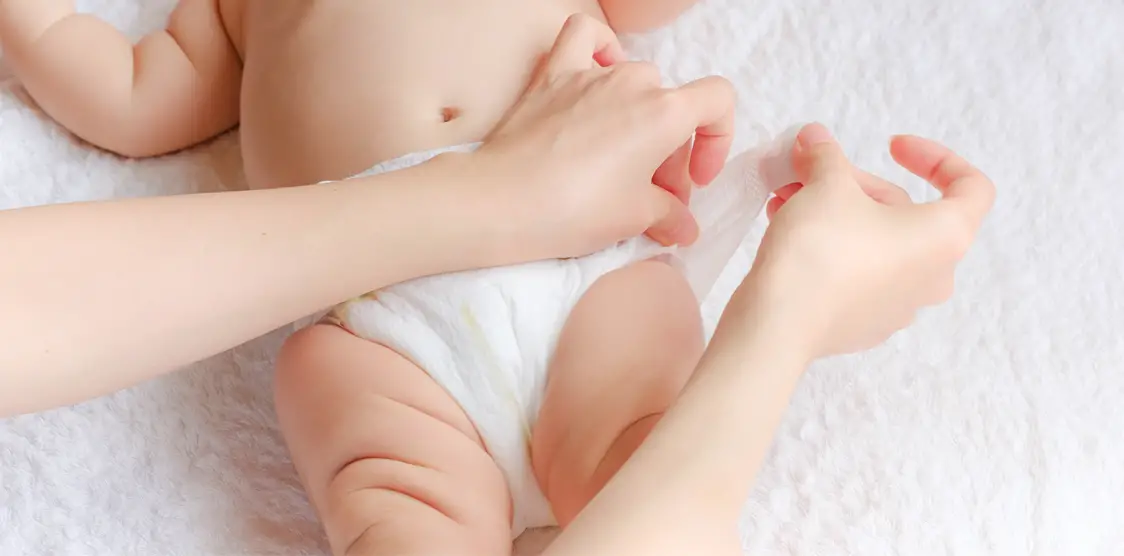Almost every new parent has encountered a red, splotchy rash on their baby’s skin while changing diapers.
My daughter was only two weeks old when I discovered her first diaper rash. During that time, we had only used reusable cloth diapers a couple of times.
Because we had no idea about any other options available, we were also using disposable baby wipes every single time we changed her diapers.
The diaper rash progressed slowly and eventually, the affected area changed into bleeding red. Obviously, due to the irritation and pain from the rash, she would cry so much every time we tried to change her diaper.
Sometimes, I would find myself crying with her as I was frustrated and had no idea what to do to fix the problem.
Frustrated and desperate to find a solution fast, I started attending a new-parents support group.
One of the mothers saw my daughter’s rash and immediately suggested I use cotton and warm water to clean her diaper area.
After I told her that I regularly used wipes to clean my baby’s bottom, she was sure that the wipes were causing the rash.
During the same meeting, one of the dads suggested using flannel squares that he and his wife used on their little girl. That gave me a very good idea.
When I got back home, I immediately cut up some old flannel sheets into hundreds of square flannel wipes which I used alongside warm water to wipe my baby’s diaper area.
They ended up becoming the perfect replacement for disposable wipes as the rash miraculously cleared up in just a few days!
What Is A Diaper Rash?

Also commonly referred to as dermatitis, diaper rash is a common type of infection that causes the baby’s skin to become sore, red, tender, and scaly.
Most children experience diaper rash at least once by the time they start potty training. So you’re probably asking, why do babies get diaper rash?
Although diaper rash is caused by several factors, one of the major causes is excessive moisture on the skin (Boiko, 1997).
Diaper rash thrives in warm, moist areas. When cloth diapers are used, the baby’s skin is more likely to become wet, which is why cloth diapers should be changed regularly.
Because babies are less likely to feel wet while in disposable diapers, some parents tend to leave them on for too long.
The excessive amount of urine in the diaper mixed with the bacteria in urine contributes to diaper rash.
Additionally, when the ammonia in the baby’s urine mixes with the plastic in the diaper, airflow is restricted and thus, the skin does not get a chance to breathe.
The combination of warmth, bacteria, and moisture provides the perfect breeding ground for the diaper rash infection.
Babies who urinate frequently or have frequent bowel movements (including diarrhea) are more susceptible to diaper rash.
To prevent diaper rash, changing the diaper frequently is highly recommended.
Although it’s not yet known how much exposure to urine or feces causes the skin to become irritated and develop a rash, experts recommend changing newborn babies every single hour and 3-4 hours for older babies, regardless of what type of diaper they are wearing. (Shin, 2005).
Diaper rash can also be caused by other factors such as yeast infection, food allergies, chemical irritation, chafing, and skin sensitivity.
For older babies who have already started eating solids, the rash can be a result of the introduction to new foods.
The introduction of new foods can cause food sensitivity as a result of a change in the contents of the baby’s stool, thus significantly increasing the risk of dermatitis.
Additionally, some types of foods can increase the frequency of bowel movement which may as a result increase the moisture content on the skin, thus increasing the risk of developing a diaper rash.
For breastfeeding infants, a change in the mother’s diet may also alter the contents of the baby’s stool, causing diaper rash (Boiko, 1979).
If antibiotics have been administered to the baby to clear up a bacterial infection, yeast infection rashes or candidal dermatitis can easily start developing in the diaper area.
You see, although antibiotics do a great job killing the infection-causing bacteria, the drugs also kill the good bacteria that prevent yeast from growing.
Without the good bacteria, the warm and moist diaper area becomes a perfect breeding ground for yeast infections to thrive in (Kazzi).
Babies who have highly sensitive skin tend to be more susceptible to diaper rash. Also, babies suffering from skin problems such as atopic dermatitis or eczema are more likely to develop diaper rashes compared to those who don’t.
In addition to getting rashes in the diaper area, babies with atopic dermatitis or eczema also get rashes on other parts of their bodies (Wong, 1992).
Another common type of diaper rash is Tidemark Dermatitis. This type of diaper rash is commonly caused by tight diapers or bindings that rub against the baby’s skin, causing painful chafing (Kazzi).
Another common cause of diaper rash is chemical irritation. Almost all disposable diapering products, including disposable wipes, are known to contain different types of chemicals that may end up causing painful irritation on the skin.
Diaper creams and lotions as well as a residual detergent, fabric softener, and bleach used during laundry can also cause skin irritation which may increase the likelihood of developing a diaper rash (Kazzi).
In the case of our little girl, we discovered that the disposable wipes we were using on her were causing her newborn rash.
Despite being a common diapering problem today, diaper dermatitis is a relatively new phenomenon.
A Montreal doctor, (Fred Weiner), who studied the diaper dermatitis rash in the 1970s, reported that nobody was aware it even existed before the use of plastic or rubber pants in the 1940s (Weiner, 1979).
One article published in the Journal of Pediatrics in 1959 reported that in one clinical study, only 7.1 percent of 1505 babies had diaper rash before the introduction of disposable diapers (Tanino, 1959).
About 20 years before the invention of disposable diapers, studies conducted in the 1980s found that at least 63 percent of 1050 babies had diaper rash at least once in 8 weeks (Gaunder and Plummer, 1987).
A recent study indicates that at least half of all babies will develop diaper rashes at least once during their diapering years (Shin, 2005).
Why Do Disposable Diapers Increase the Likelihood of Developing Dermatitis?
In his study, Fred Weiner discovered that restricted airflow in tight-fitting plastic or rubber covers was one of the major causes of rashes in newborns.
He also found that the use of plastic or rubber pants increased the risk of developing rashes (Weiner, 1979).
The problem with disposable diapers is that they are made with a wide variety of chemicals and sadly, manufacturers refuse to disclose the specific ingredients used to make these modern diapers.
However, it’s a well-known fact that manufacturers of disposable diapers use the following ingredients; polypropylene plastic, polyethylene film, stearyl alcohol, petrolatum, bleached paper pulp, cellulose tissue, hot melts, elastic, and perfume.
Also included are SAPs (super absorbent polymers which are also commonly referred to as absorbent gelling material that prevents the diaper from leaking.
The SAPs in disposable diapers are known to cause skin irritation as well as serious allergic reactions such as vomiting, fever, and staph infections.
The use of SAPs in tampons was banned in 1985 after they were strongly linked to toxic shock syndrome.
When extremely wet, the gel material in the diaper can leak and get in contact with your child’s skin, causing further irritation (Landbank, 1991).
Disposable diapers have also been found to contain traces of highly toxic chemicals such as tributyl-in (TBT) and dioxin.
TBT has been found to cause hormonal issues in both humans and animals while dioxin, a by-product of the bleaching process, is a carcinogenic chemical that is listed by the EPA as one of the most toxic cancer-causing chemicals.
The chemical is banned in a large number of countries except for the US (Greenpeace, 1994).
Given the number of potentially harmful ingredients in disposable diapers, it’s not a surprise that these diapers increase lead to a higher incidence of rashes and allergic reactions in babies using these diapers.
Another question is, “How do you view the connection between diapers and dermatitis.”?
What Type of Diapers Are More Likely to Cause Diaper Rash?

Well, from our research, it appears that most studies tend to favor the use of disposables for diaper rash prevention.
A big majority of pediatrics also believe that disposable diapers are a much better option when it comes to keeping the baby dry and free from rashes compared to reusable cloth diapers.
It’s very hard to find studies or medical professionals supporting the use of cloth diapers.
But the question is if disposable diapers contain harmful chemicals, doesn’t it make total sense that these diapers are more likely to cause diaper rash? It’s easy to see that the reasons for this are both economical and political.
Dr.Fred Weiner happens to be one of the many people who appeared to favor the use of disposable diapers over cloth diapers.
In one of his diaper rash studies, Dr.Weiner found that out of the 146 infants who came for their one-month check-up, those who wore disposables had 20 percent more incidences of diaper rash compared to those using cloth diapers with plastic pants, and 3 times more compared to infants wearing cloth diapers alone.
Unfortunately, the doctor did not collect information regarding the frequency of diaper changes or the overall health of the children.
These could have potentially been crucial factors in the development of the diaper rashes.
His study was not blinded as he very well knew which parents used disposables and which ones used reusable cloth diapers.
All the same, Dr.Weiner was able to conclude that disposable diapers prevented babies’ skin from breathing and that tight-fitting diapers must be avoided (Weiner, 1997).
Another study that was supported by a grant from Johnson and Johnson in 1982 still did not demonstrate the superiority of disposables.
Unlike in the other aforementioned studies, this particular study was “double-blinded”, which means that not only were the study examiners in the dark about the type of diapers the participants were wearing but the parents of the infants were unaware that they were participating in a diaper rash study.
The goal of this double-blinded study was to eliminate any bias from either the examiners or the parents towards a certain diapering system.
To some extent, the study was controlled by standardizing skincare. There were no recommendations given regarding the frequency of diaper changes or laundry practices.
The study results indicated that there was no significant difference between disposable diapers and cloth diapers when it came to diaper rash (Stein, 1982).
In the first 20-year period that disposables were in the market, they mainly consisted of cellulose fluff as the absorbent material.
However, in the mid-1980s, the gel SAPs slowly began to replace cellulose fluff.
The gel material inside disposable diapers is perfectly capable of absorbing a high amount of liquid- usually up to 80 times its normal weight.
Several years after SAP diapers were introduced, manufacturers would produce both the SAP and cellulose fluff diapers.
However, with time, diapers with cellulose fluff or rather non-SAP diapers were eventually phased out (Shin, 2005).
Today, a large percentage of the disposable diapers in the market contain SAP. However, you can still get eco-friendly disposables at a natural food store.
Studies supporting disposable diapers claim that the superabsorbent polymers in disposables are the main reason why fewer babies get diaper rashes while using this kind of diaper. A good number of pediatricians also seem to believe this as well.
They argue that diaper rash is mainly caused by excessive moisture on the baby’s skin and the SAPS in the disposables help absorb the moisture away from the baby’s skin (Boiko, 1997).
But when you become keener, you’ll ultimately find out that most of these studies favoring disposable diapers are sadly influenced by the manufacturers.
These manufacturers either manipulate the final results of these studies or sponsor some of these studies.
A good example is the two studies that were conducted in 1987 which discovered that babies who wore diapers containing the absorbent gel material were less affected by diaper rash compared to those wearing cotton diapers.
The other study compared three diapering systems which included two types of disposable diapers and reusable cloth diapers. However, the said study did not in any way control how the cloth diapers were used or washed.
There was also no mention of the type of cotton cloth diaper used or the type of diaper cover used (wool or plastic).
The amount of detergent used was also not measured, plus there was no mention of how often the diapers were washed.
The authors of the studies admitted that no attempt was made to either control or change the diaper care or skincare habits of the participating families (Campbel et al, 1987). A few other issues with the study were also noted.
The participants that used the two types of disposable diapers were blinded, which simply means that the examiners had no idea what diapering product was used on a particular child.
The cloth diapering participants were not blinded though. If the examiners ended up being biased against cloth diapers, it could have ultimately influenced their final say.
Furthermore, one of the leading manufacturers of disposable diapers sponsored the entire study.
Another study performed in 1989 on diaper maintenance compared 7 brands of reusable cloth diapers of different types.
They included cotton, terry, flannel, birdseye, and others, 5 types of disposable diapers with SAP, and four types of conventional disposable diapers.
Once again, the diapers with super absorbent polymers were found to perform better as far as keeping the skin dry is concerned.
When it came to keeping the skin dry, the study experts found no significant difference between conventional disposables and cloth diapers (Wilson, 1990).
This particular study was however not conducted on babies- it was carried out on college student volunteers who wore diaper samples on their arms.
Each diaper patch consisted of synthetic urine and the study participants had to wear them for about two hours.
The amount of moisture absorbed by the patch was also recorded. In this case, the laundry practices were not taken into consideration.
The question is, would the results of the study be relevant considering it was not carried out on a baby’s skin?
I find that the topic of diaper rash and diapering systems has not been adequately addressed by these studies. The generalizations by pediatricians and researchers are also not satisfactory.
Although most researchers and pediatricians may disagree, using disposable diapers for prolonged periods seems quite risky.
Unlike cloth diapers which are changed often because the baby is likely to feel the wetness sooner, most parents often leave throwaway diapers on their kids too long. This increases the risk of getting a diaper rash.
Most previous studies may have failed to provide satisfactory answers because they fail to consider advances in the design of both disposables and cloth diapers.
Although the older studies comparing the cellulose fluff, conventional, and old cloth diapers are worth learning from, they are not relevant in modern-day diapers.
Interestingly, the manufacturers of disposable diapers have enough funds to spend on good research and development, that’s why they are always trying to challenge science and prove to everyone that their diapers are more superior to washable cloth diapers.
For this reason, disposable diapers have changed over the years, just like cloth diapers.
Over the past few years, parents have been using a wide variety of cloth diapering products, including pocket and all-in-one diapers. Some parents have also ditched plastic covers in favor of wool covers.
Based on these findings, it’s pretty clear that a new study on diaper rash is needed.
The study must cut any influence from disposable diaper manufacturers and also needs to be blinded and also controlled with a wide variety of cloth diapers, types of diaper covers used, an equal number of diaper changes performed, and also standardized laundry practices.
New research must also look into the health impact of SAP and chemicals found in disposable diapers on babies.
Ultimately, an unbiased study that carefully examines all angles of diaper rash and the role of diapers is needed.
But until we get new data regarding diaper rash, parents must ensure frequent diaper changes and keep their babies’ diaper area clean because diaper rash is under the control of the children’s primary caregivers.
Sources:
- Allsopp, Michelle. Achieving Zero Dioxin: An emergency strategy for dioxin elimination. September 1994. Greenpeace.
- Boiko, S. (1997). Diapers and diaper rashes. Dermatology Nursing. 2/1/1997.
- Borkowski, S. (2004). Diaper rash care and management. Pediatric Nursing, 11/1/2004.
- Campbell, R. et al. (1987). Clinical studies with disposable diapers. Journal of the American Academy of Dermatology, 17: 978-987.
- Gaunder, B. and E. Plummer. (1987). Diaper rash: managing and controlling a common problem in infants and toddlers. Journal of Pediatric Health Care. 1: 26-34.
- Greenpeace. New Tests Confirm TBT Poison in Procter & Gamble’s Pampers: Greenpeace Demands World-Wide Ban of Organotins in All Products. 15 May 2000.
- Kazzi, A.A. Pediatrics, Diaper Rash. eMedicine, http://www.emedicine.com/emerg/topic374.htm
- The Landbank Consultancy Limited. A Review of Procter & Gamble’s Environmental Balances for Disposable and Re-useable Nappies. July 1991.
- Seymour, J.L. et al (1987). Clinical effects of diaper types on the skin of normal infants and infants with atopic dermatitis. Journal of the American Academy of Dermatology, 17: 988-997.
- Shin, H.T. (2005). Diaper dermatitis that does not quit. Dermatologic Therapy, 18: 124-135.
- Stein, H. (1982). Incidence of diaper rash when using cloth and disposable diapers. The Journal of Pediatrics, 101: 721-723.
- Tanino, J. et al. (1959). The relationship of perinatal dermatitis to fecal pH. The Journal of Pediatrics, 54: 793-800.
- Weiner, F. (1979). The relationship of diapers to diaper rashes in the one-month-old infant. The Journal of Pediatrics, 95: 422-424.
- Wilson, P.A. et al. (1990). Diaper Performance: Maintenance of Healthy Skin. Pediatric Dermatology, 7: 179-184.
- Wong, D.L. et al. (1992). Diapering Choices: A Critical Review of the Issues. Pediatric Nursing, 18: 41-54.

As a mother of four very energetic children, Emilia knows how chaotic motherhood can be. She’s learned a lot of lessons along the journey so far and loves sharing the tips & tricks she’s picked up over the years with anybody else on the same life path.

